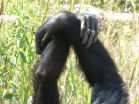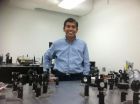(Press-News.org) A research collaboration between the Gonzaga University and the Max Planck Institute shows that the way in which chimpanzees groom each other depends on the community to which they belong. Specifically, it is the unique handclasp grooming behaviour that reveals this local difference.
The specific behaviour that the researchers focused on was the 'grooming handclasp', a behaviour where two chimpanzees clasp onto each other's arms, raise those arms up in the air, and groom each other with their free arm. This behaviour has only been observed in some chimpanzee populations. The question remained whether chimpanzees are instinctively inclined to engage in grooming handclasp behaviour, or whether they learn this behaviour from each other and pass it on to subsequent generations.
Edwin van Leeuwen and Katherine Cronin of the Comparative Cognitive Anthropology research group of the Max Planck Institute for Psycholinguistics led by Daniel Haun conducted their observations between 2007 and 2012 at the Chimfunshi Wildlife Orphanage Trust in Zambia. At Chimfunshi, a mix of wild- and captive-born chimpanzees live in woodlands in some of the largest enclosures in the world. The Max Planck team collaborated with students from Gonzaga University led by Mark Bodamer, a team of local chimpanzee caretakers, and Roger Mundry of the Max Planck Institute for Evolutionary Anthropology in order to collect and comprehend the detailed chimpanzee data.
VIDEO:
Chimpanzees "Daisey " and her mother "Diana " engage in a palm-to-palm grooming handclasp, then switch to the wrist-to-wrist style.
Click here for more information.
Previous research suggested that the grooming handclasp might be a cultural phenomenon, just like humans across cultures engage in different ways of greeting each other. However, these suggestions were primarily based on observations that some chimpanzee communities handclasp and others don't – not whether there are differences between communities that engage in handclasping. Moreover, the early observations could have been explained by differences in genetic and/or ecological factors between the chimpanzee communities, which precluded the interpretation that the chimpanzees were exhibiting 'cultural' differences.
The present research shows that even between chimpanzee communities that engage in the grooming handclasp, subtle yet stable differences exist in the styles that they prefer: one chimpanzee group highly preferred the style where they would grasp each other's hands during the grooming, while another group engaged much more in a style where they would fold their wrists around each other's wrists.
"We don't know what mechanisms account for these differences", van Leeuwen says. "But our study at least reveals that these chimpanzee communities formed and maintained their own local grooming traditions over the last 5 years. Our observations may also indicate that chimpanzees can overcome their innate predispositions, potentially allowing them to manipulate their environment based on social constructs rather than on mere instincts."
VIDEO:
At the beginning of the video two chimpanzees engage in the palm-to-palm handclasp with their left arms, then transition to the same style with their right arms. About a minute...
Click here for more information.
Apart from the different style preferences of the chimpanzee communities, the research team also observed that the grooming handclasp behaviour was a long-lasting part of the chimpanzees' behavioural repertoire: the behaviour was even transmitted to the next generation of potential handclaspers.
"By following the chimpanzees over time, we were able to show that 20 young chimpanzees gradually developed the handclasp behaviour over the course of the five-year study. The first handclasps by young individuals were mostly in partnership with their mothers. These observations support the conclusion that these chimpanzees socially learn their local tradition, and that this might be evidence of social culture", Bodamer explains.
"Continued monitoring of these groups of chimpanzees will shed light on the question of how these group-traditions are maintained over time and potentially even why the chimpanzees like to raise their arms up in the air during social grooming in the first place", van Leeuwen adds.
INFORMATION:
Original publication:
Edwin J. C. van Leeuwen, Katherine A. Cronin, Daniel B. M. Haun, Roger Mundry and Mark D. Bodamer
Neighbouring chimpanzee communities show different preferences in social grooming behaviour
Proceedings of the Royal Society B, August 29, 2012
LINK: http://rspb.royalsocietypublishing.org/lookup/doi/10.1098/rspb.2012.1543
Chimpanzees create social traditions
Researchers have revealed that chimpanzees are not only capable of learning from one another, but also use this social information to form and maintain local traditions
2012-08-29
ELSE PRESS RELEASES FROM THIS DATE:
Breakthrough in nanotechnology
2012-08-29
A University of Central Florida assistant professor has developed a new material using nanotechnology, which could help keep pilots and sensitive equipment safe from destructive lasers.
UCF Assistant Professor Jayan Thomas, in collaboration with Carnegie Mellon University Associate Professor Rongchao Jin chronicle their work in the July issue of the journal Nano Letters. (http://dx.doi.org/10.1021/nl301988v)
Thomas is working with gold nanoparticles and studying their properties when they are shrunk into a small size regime called nanoclusters. Nanoparticles are already ...
Soaking up the Sun
2012-08-29
Solar panels, like those commonly perched atop house roofs or in sun-drenched fields, quietly harvesting the sun's radiant energy, are one of the standard-bearers of the green energy movement. But could they be better – more efficient, durable and affordable? That's what engineers from Drexel University and The University of Pennsylvania are trying to find out, with the aid of a little nanotechnology and a lot of mathematical modeling.
A three-year grant from the National Science Foundation has set the team on a track to explore ways to make new photoelectric cells more ...
TacSat-4 participates in Navy fleet experiment Trident Warrior
2012-08-29
WASHINGTON –- U.S. Naval Research Laboratory's Tactical Satellite-4 successfully completes three weeks of intense testing, June 28, as part of the Navy's annual Trident Warrior Experiment 2012 (TW12). TacSat-4 is a Navy-led Joint mission that provides Ultra High Frequency (UHF) satellite communications (SATCOM).
Sponsored by Navy Warfare Development Command, Trident Warrior is an annual fleet experiment focused on gaining valuable insights to improve future capability investments. This year's agenda included at-sea experimentation of critical maritime initiatives, and ...
Many trendy 'microgreens' are more nutritious than their mature counterparts
2012-08-29
The first scientific analysis of nutrient levels in edible microgreens has found that many of those trendy seedlings of green vegetables and herbs have more vitamins and healthful nutrients than their fully grown counterparts. A report on the research appears in ACS' Journal of Agricultural and Food Chemistry.
Qin Wang, Gene E. Lester and colleagues point out that microgreens have gained popularity as a new culinary trend over the past few years, especially in upscale markets and restaurants. Those seedlings of spinach, lettuce, red cabbage and other veggies are usually ...
Warning on deterioration of famous Swedish warship, Vasa
2012-08-29
The famous warship, Vasa, displayed in a museum that gets 1.2 million visitors every year and ranks as one of Sweden's most popular tourist attractions, is deteriorating despite ongoing preservation efforts, scientists are reporting. Their study, citing a "significant" loss of strength in the ship's wood, appears in ACS' journal Biomacromolecules.
Ingela Bjurhager, Lars A. Berglund and colleagues explain that the Vasa sunk in the Stockholm harbor in 1628 on its maiden voyage after sailing less than a nautical mile. The ship was rediscovered in 1958, raised in 1961, treated ...
New antibacterial coating for sutures could reduce infections after surgery
2012-08-29
Responding to an urgent need for better antibacterial coatings on surgical sutures, scientists are reporting the discovery of a new coating that is almost 1,000 times more effective than the most widely used commercial coating. Their report appears in ACS' journal Langmuir.
Professor Gregory Tew, who is from UMass-Amherst, and colleagues explain that infection at the site of surgical incisions is one of the most common post-surgical complications that keep patients hospitalized longer and boost hospital bills. The most common antibiotic coating contains triclosan, but ...
A new approach for controlling the skyrocketing cost of health care
2012-08-29
A potentially powerful new approach for limiting health care costs — which account for almost $1 out of every $5 spent in the U.S. each year — is the topic of the feature story in this week's edition of Chemical & Enginering News (C&EN), the weekly news magazine of the American Chemical Society (ACS), the world's largest scientific society.
C&EN Senior Correspondent Marc S. Reisch explains that one until-now neglected way to reign in health care spending involves providing patients and doctors with better diagnostic tests. Such tests could save money by providing greater ...
URI oceanographers find there is one-third less life on Earth
2012-08-29
NARRAGANSETT, R.I. – August 29, 2012 -- Estimates of the total mass of all life on Earth should be reduced by about one third, based on the results of a study by a team of scientists at the University of Rhode Island's Graduate School of Oceanography and colleagues in Germany.
The research was published this week in the Proceedings of the National Academy of Science.
According to previous estimates, about one thousand billion tons of carbon is stored in living organisms, of which 30 percent is in single-cell microbes in the ocean floor and 55 percent reside in land ...
More research needed on the best treatment options for multidrug-resistant TB
2012-08-29
The use of newer drugs, a greater number of effective drugs, and a longer treatment regimen may be associated with improved survival of patients with multidrug resistant tuberculosis (MDR-TR), according to a large study by a team of international researchers published in this week's PLOS Medicine.
Global efforts to control tuberculosis are being challenged by the emergence of strains that are resistant to several antibiotics including isoniazid and rifampicin, the two most powerful, first-line (standard) anti-tuberculosis drugs—so-called multidrug resistant tuberculosis ...
Adverse effects of mining industry provoke hard questions for medical humanitarian organizations
2012-08-29
Increasingly humanitarian organizations will find themselves responding to health emergencies provoked by the adverse effects of mining and other extractive industries, setting up a potential clash to do with the core principles and values at the heart of humanitarian medicine, writes Philippe Calain from the humanitarian medical organization, Médecins Sans Frontières (MSF), in this week's PLOS Medicine.
"A pragmatic approach of engagement with the corporate sector for the delivery of aid, or an implicit support to mainstream development agendas could compromise the ...
LAST 30 PRESS RELEASES:
Beech trees use seasonal soil moisture to optimize water uptake
How thinning benefits growth for all trees
Researchers upgrades 3-PG forest model for improved accuracy
Achieving anti-thermal-quenching in Tb3+-doped glass scintillators via dual-channel thermally enhanced energy transfer
Liquid metal modified hexagonal boron nitride flakes for efficient electromagnetic wave absorption and thermal management
Failure mechanisms in PEM water electrolyzers
Study captures how cancer cells hide from brain immune cells, shows that removing their “don’t eat me” signals stops their escape
New breakthrough in detecting ‘ghost particles’ from the Sun
Half of people arrested in London may have undiagnosed ADHD, study finds
From dots to lines: new database catalogs human gene types using ’ACTG’ rules
Persistent antibiotic resistance of cholera-causing bacteria in Africa revealed from a multinational workshop for strengthening disease surveillance
SwRI, Trinity University to synthesize novel compound to mitigate effects of stroke, heart attack
Novel endocrine therapy giredestrant improves disease-free survival over standard of care for patients with early-stage breast cancer in phase III lidERA trial
Gen Z views world as "scary place" with growing cynicism about ability to create change
Biosensor performance doubled – New applications possible
Leveraging incomplete remote sensing for forest inventory
Key chemical in dark chocolate may slow down ageing
New 15-minute hepatitis C test paves the way for same-day treatment
Uranus and Neptune might be rock giants
Magnetically actuated soft electrodes for multisite bioelectrical monitoring of ex vivo tissues
FAU engineers decode dementia type using AI and EEG brainwave analysis
Carrier-free peptide–daunorubicin–small interfering RNA nanoassembly for targeted therapy of acute myeloid leukemia
Global Virus Network announces appointment of new board members
Artificial beaver dams show promise in offsetting climate change effects
Could hidden infections be fueling long COVID?
Targeted oxygen for initial resuscitation of preterm infants
Researchers develop models to help diagnose ALS earlier through blood biomarkers
Jeonbuk National University researchers develop novel eco-friendly and photo-switchable smart adhesives
Magnetic ordering induces Jahn–Teller effect in spinel-type compounds
A mitochondrial protein may hold the secret to longevity, new study finds
[Press-News.org] Chimpanzees create social traditionsResearchers have revealed that chimpanzees are not only capable of learning from one another, but also use this social information to form and maintain local traditions


